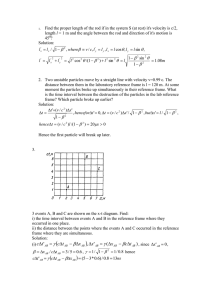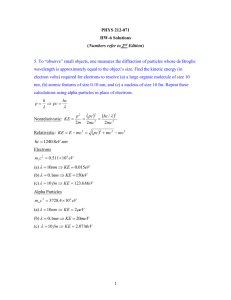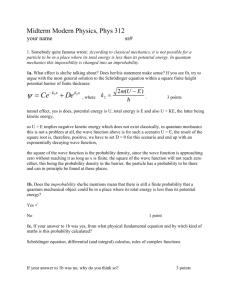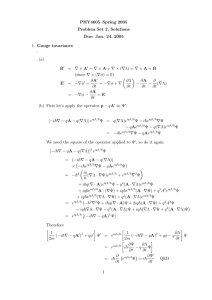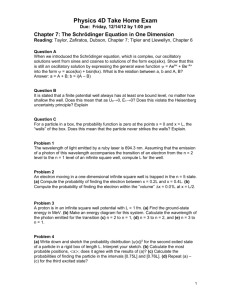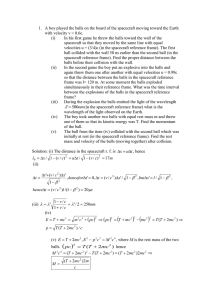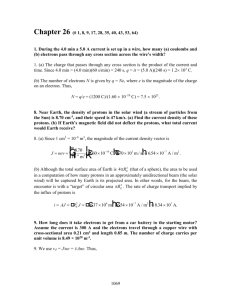doc
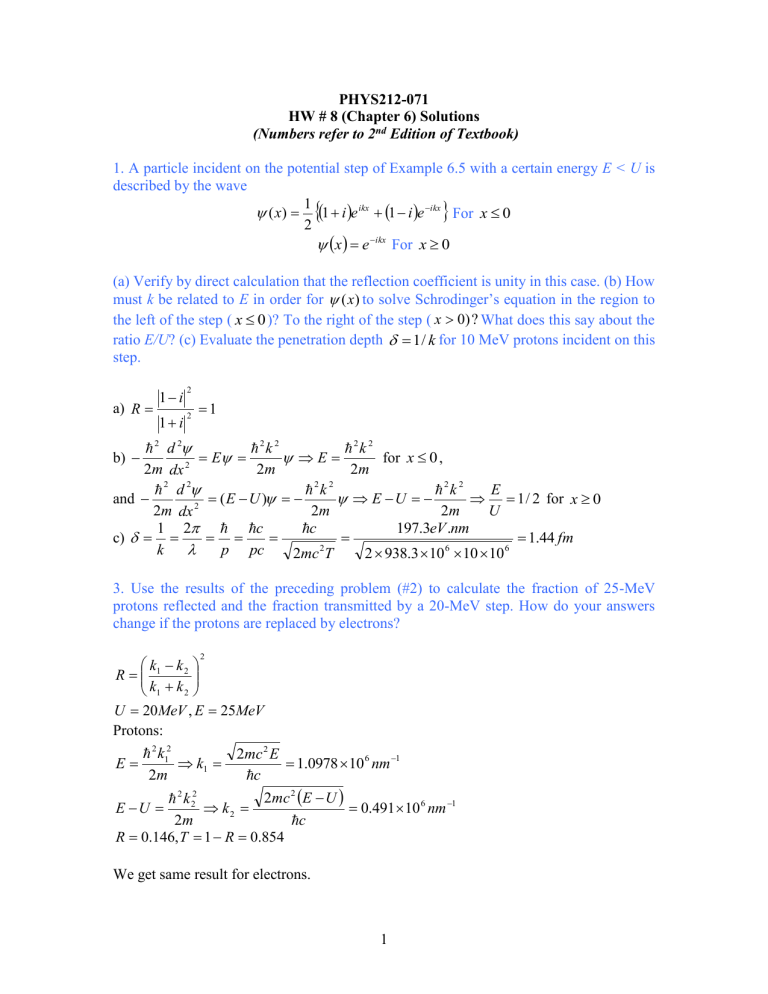
PHYS212-071
HW # 8 (Chapter 6) Solutions
(Numbers refer to 2 nd Edition of Textbook)
1. A particle incident on the potential step of Example 6.5 with a certain energy E < U is described by the wave
( x )
1
2
e ikx
e
ikx
For x
0
e
ikx
For x
0
(a) Verify by direct calculation that the reflection coefficient is unity in this case. (b) How must k be related to E in order for
( x ) to solve Schrodinger’s equation in the region to the left of the step ( x
0 )? To the right of the step ( ratio E/U ? (c) Evaluate the penetration depth
1 / k x
0 ) ?
What does this say about the for 10 MeV protons incident on this step. a) R
1
i
2
1
i
2
1 b) and c)
2
2 m
2 d 2
dx
2 d
2
2 m
1 k
dx
2
2
E
( E
p
U
2 k
2 m
c pc
)
2
E
2 k
2
c
2 m
2 mc
2
T
2 k 2
2 m
for x
0 ,
E
U
2 k
2
2 m
197 .
3 eV .
nm
2
938 .
3
10
6
E
U
10
10
6
1 / 2 for x
0
1 .
44 fm
3. Use the results of the preceding problem (#2) to calculate the fraction of 25-MeV protons reflected and the fraction transmitted by a 20-MeV step. How do your answers change if the protons are replaced by electrons?
R
U
k
1 k
1
20
k k
MeV
2
2
, E
2
25 MeV
Protons:
E
E
R
2 k
1
2
2 m
k
1
2 k
2
2
U
0 .
2 m
146 , T
1
k
2
R
2 mc
2
E
1 .
0978
10
6 nm
1
c
2 mc
2
E
U
0 .
854
c
0 .
491
10
6 nm
1
We get same result for electrons.
1
4. A 0.100 mA electron beam with kinetic energy 54.0 keV enters a sharply defined region of lower potential where the kinetic energy of the electrons is increased by 10.0 eV. What current is reflected at the boundary? (This simulates electron scattering at normal incidence from a metal surface, as in the Davisson-Germer experiment.)
I
R
0 .
100 mA , T
1
k k
1
1
k
2
k
2
2
54 .
0 eV , T
2
64 .
0 eV k
1
2 mc
2
T
1
c
0 .
037
10
3 nm
1 k
2
R
2 mc
2
c
0 .
18 %
I
T
2
R
0 .
041
10
3 nm
1
0 .
18
A
5. (a) Tunneling of particles through barriers that are high or wide (or both) is very unlikely. Show that for a square barrier with
2 mUL
2
1
2
And particle energies well below the top of the barrier (E << U), the probability for transmission is approximately
P
E
16
U exp
2
2 m
U
E
L
(The combination UL
2
is sometimes referred as the barrier strength).
(b) Give numerical estimates for the exponential factor in P for each of the following cases: (1) an electron with U – E = 0.01
eV and L = 0.1 nm ; (2) an electron with U – E =
1 eV and L = 0.1 nm ; (3) an alpha particle ( m = 6.7 x 10
-27
kg ) with U – E = 10
6 eV and L
= 10 -15 m ; and (4) a bowling bowl ( m = 8 kg ) with U – E = 1J and L = 2 cm (this corresponds to the ball’s getting past a barrier 2 cm wide and too high for the ball to slide over).
T sinh
1
1
1
4
1
2
E
2
U
U
E
sinh
e
L e
L
2
U
2 m
U
E
E
T
1
1
16
U
E
1 e
2 L 2 m
U
E
/
E
16
U e
2 L 2 m
U
E
/
2
e
2 L 2 m
U
E
/
= 0.90, 0.36, 0.42, 0
3
